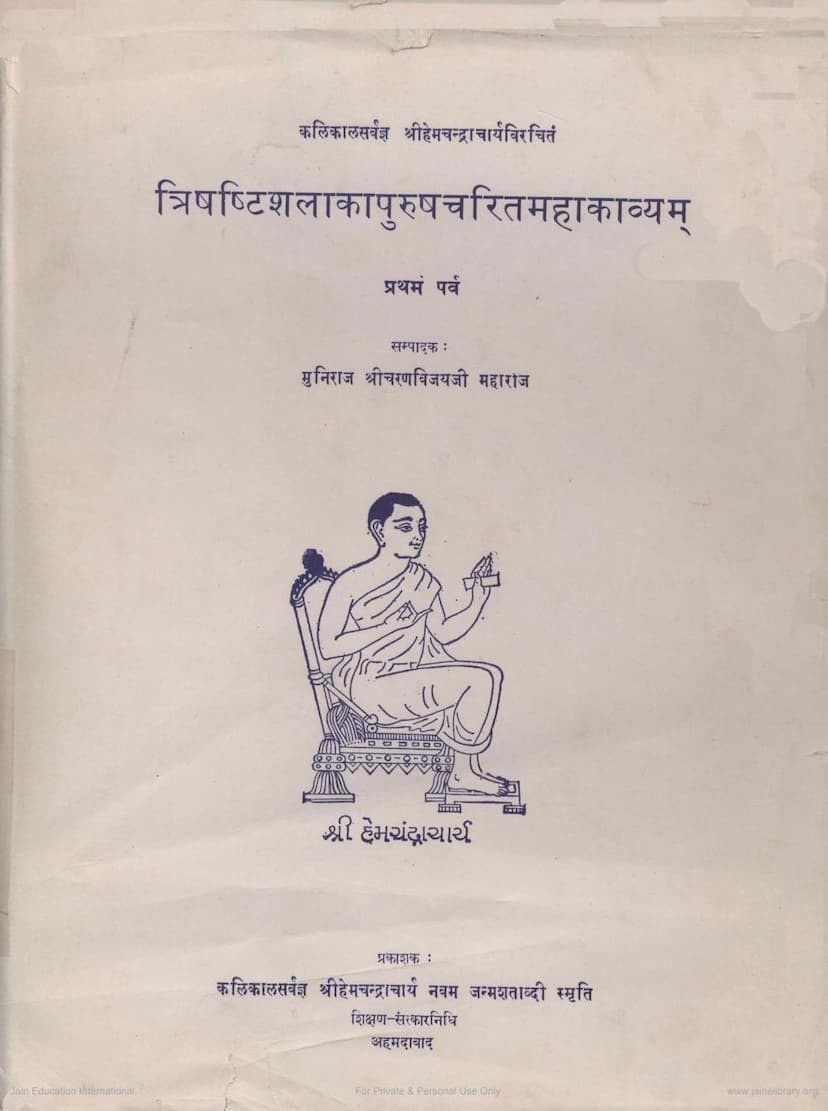Trishashtishalakapurushcharitammahakavyam Parva 1
Added to library: September 2, 2025

Summary
The Trishashtishalakapurushcharitra, compiled by Hemchandracharya and edited by Muni Raj Shree Charanjivijayji Maharaj, is a monumental epic poem in Sanskrit, divided into ten parts (Parvas). This summary focuses on the first part, which is the beginning of this vast work.
Key Aspects of the First Part (Parva 1) and the Publisher's Preface:
- Title: Trishashtishalakapurushcharitra Mahakavyam, Pratham Parva (The Great Epic of the Sixty-Three Salakapurushas, First Part).
- Author: Kalikal Sarvagya Shree Hemchandracharya.
- Editor: Muniraj Shree Charanjivijayji Maharaj.
- Publisher: Kalikal Sarvagya Shree Hemchandracharya Navam Janmashatabdi Smruti Sanskar Shikshan Nidhi, Ahmedabad.
- Content: The epic is a vast narrative detailing the lives of the 63 "Salakapurushas" (distinguished individuals) in Jainism. These include the 24 Tirthankaras, 12 Chakravartis (universal emperors), 9 Vasudevas, 9 Baladevas, and 9 Prativasudevas, all of whom are considered spiritually significant figures. The first Parva, as outlined in the detailed table of contents, begins with the lineage and the birth of the first Tirthankara, Lord Rishabhanatha, and the early life and events related to him and his son, Bharat Chakravarti. The table of contents is incredibly detailed, outlining numerous individual stories, descriptions of time cycles (Yugas), descriptions of continents (Dvipas), celestial beings, religious teachings, virtues like dana (charity), shila (ethics), tapa (penance), and bhava (inner disposition), and philosophical discussions.
- Significance: The Trishashtishalakapurushcharitra is considered a highly important and influential work in Jain Sanskrit literature. It is renowned for its encyclopedic scope, covering the lives of these key figures in detail, spanning over 36,000 verses. The text has been continuously studied and revered since its creation, attesting to its enduring relevance and utility.
- Reprint and Editing: The preface highlights that this edition is a re-publication. The work was initially edited and published in parts, with the first volume of the first Parva appearing in 1936 CE (VS 1992). Due to the unfortunate demise of the editor shortly after, the subsequent parts were completed by other scholars. This particular re-publication aims to present a critically edited and revised version based on various ancient palm-leaf and other manuscripts, including footnotes for textual variations and commentary.
- Accessibility: The preface mentions that the work is not only read by Jain monks and nuns but also by the non-Jain community and scholars worldwide. English translations of parts of the work have also been published.
- Appendices: This specific edition includes appendices:
- Appendix 1: Alphabetical index of verses.
- Appendix 2: Index of special names mentioned in the text.
- Appendix 3: Compilation of important sayings and passages (sukti-kandika).
- Errata: A list of corrections for errors found in previous editions.
- Editorial Effort: The preface acknowledges the significant effort put forth by various monks and sadhvis in preparing these appendices and ensuring the accuracy of the text.
- Future Plans: The publishers express their intention to publish the remaining parts of the Trishashtishalakapurushcharitra, based on ancient manuscripts, with further editing by Pandit Shree Shilchandravijayji.
- Financial Support: The publication received financial support from Shree Jain Shwetambar Murtipujak Boarding, Ahmedabad.
In essence, the first part of the Trishashtishalakapurushcharitra, as presented in this publication, serves as an introduction to the epic narrative of the most revered figures in Jainism, meticulously edited and presented with scholarly apparatus for the benefit of a wide audience. The publisher's preface emphasizes the immense historical, literary, and religious significance of Hemchandracharya's masterpiece.